Wader varieties at Montrose Basin – part 3.
This week we’ll be looking at the last of the waders you’re most likely to see at Montrose (of course there are more, but they’re just not as common). This group will mostly cover the medium to large waders.
Knots.
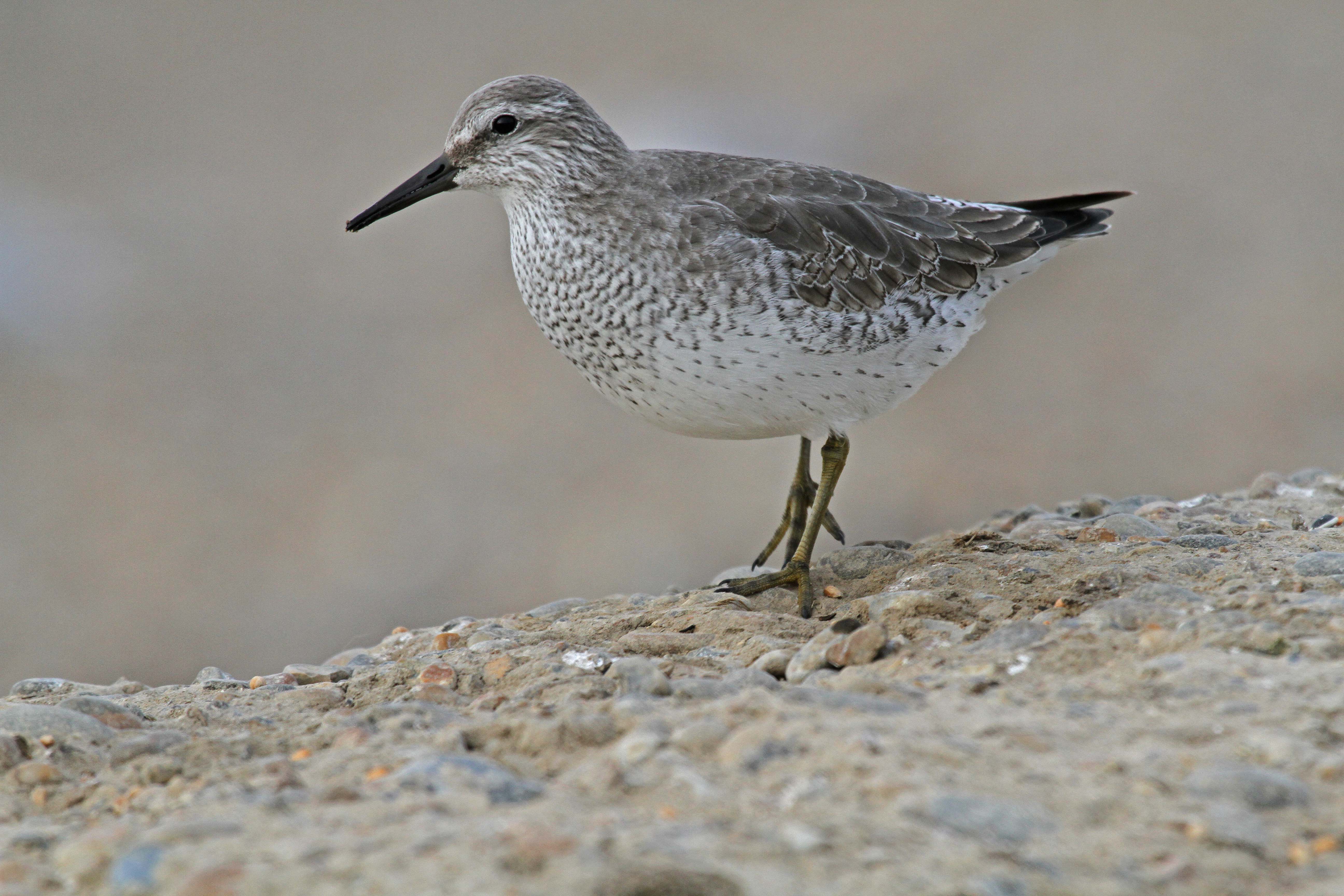
Only an inch or two shorter than redshanks, knots are usually described as being ‘dumpy’ with a medium-to-short, black bill and short, pale grey/green legs. During the breeding season, the adults’ plumage is a deep rufous (red/brown, almost like rust) colour along the head, chest, and belly, with a similar colour through the wing feathers. While we’re unlikely to see adults in full breeding colour (they usually breed in the Arctic), we do get a number of individuals with patches of rufous remaining as they moult into their winter plumage. Over winter, knots are a pale grey on top and white on the belly and chest, with a pale line over the eye. This grey will become a little bit browner by spring as they begin to return to their breeding plumage. Usually found in large numbers right on the edge of the tide, this behaviour has linked the bird to King Canute, which is why it’s called a Knot.
While they may not have any striking feature over winter, their migration is pretty spectacular with some groups travelling over 9000 miles to get to their breeding grounds.
Turnstones.
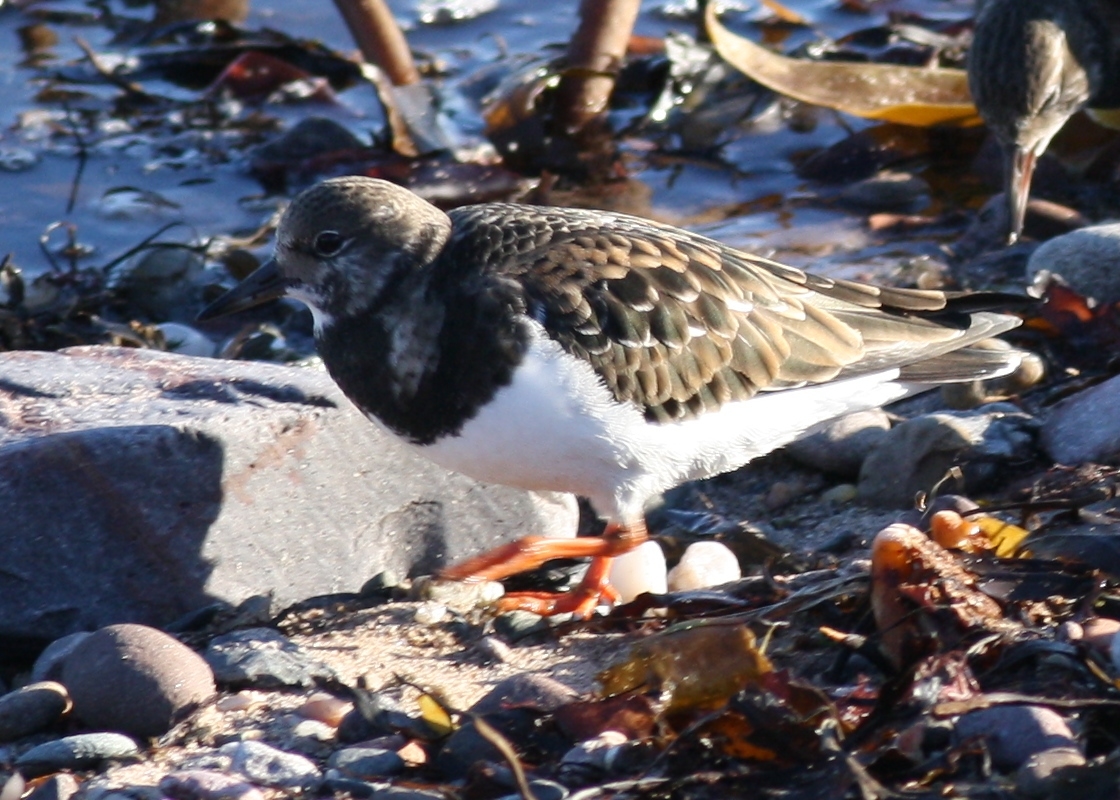
Named because it quite literally turns over stones and shells looking for small crustaceans and molluscs, it is similar in size to a ringed plover, with short, thick, orange legs; a short, black bill; and a dark plumage which makes it difficult to see in this environment. Turnstones are easier to see during the breeding season when they have a chestnut back, bright white belly, black band across the chest, and a black and white head. During the winter months their head darken to a black and their chestnut wing plumage becomes a dark brown. However, their white belly and black chest band remains throughout the year. The juveniles look very similar to wintering adults but have paler cheeks and throat, the plumage appearing more tortoiseshell than dark brown.
It’s another small bird that carries out long migration, many migrating as far south as South Africa over the winter.
Black-tailed godwits.
The godwits can be difficult to tell apart, especially when their most distinctive feature (the barred or black tail) is hidden when not in flight.
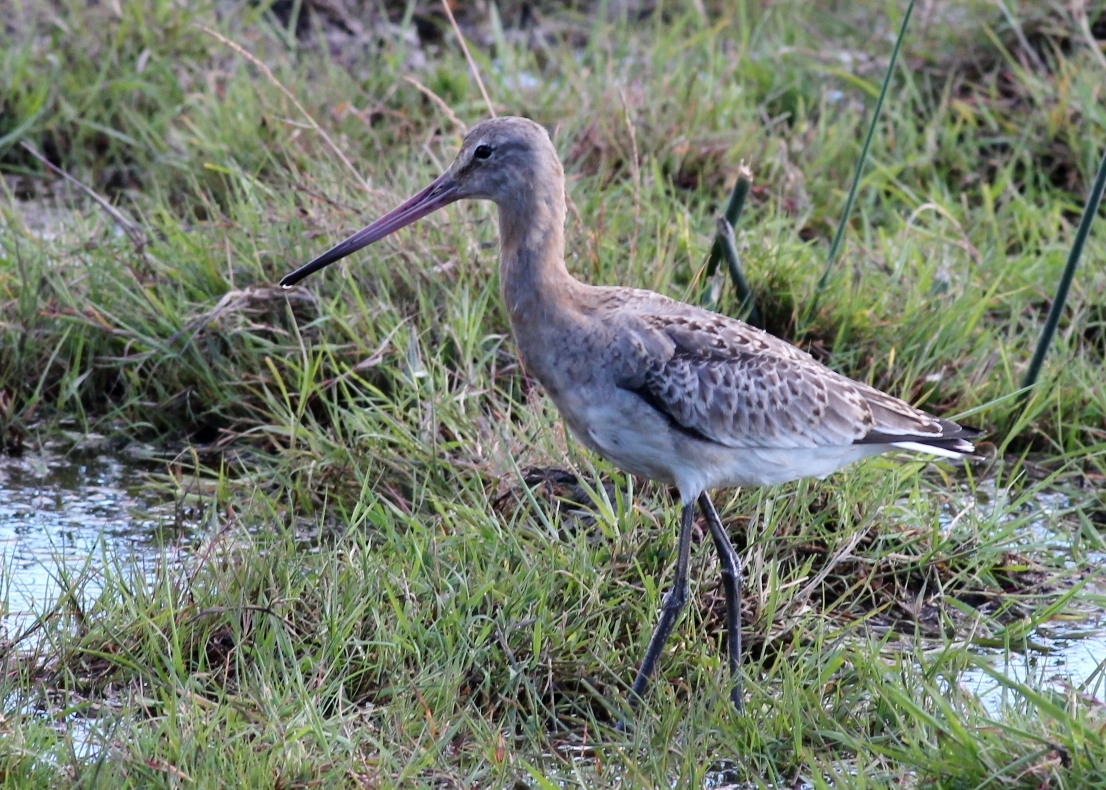
Black-tailed godwits are large waders (though much smaller than curlew), with particularly long legs and bill. In fact, the bill often looks too large for the bird. Their legs are a dark grey/ black colour all year round and the bill also having a black tip all year round. The base of the bill does change with the season, during the breeding season it is an orange/pink colour and during winter it is pink. The plumage also varies throughout the season, with the head, chest and parts of the wing feathers being a rusty red colour; the belly white; and the flanks containing dark bars. During the winter this bright plumage becomes a uniform grey/brown along the head, chest, and back, though you can sometimes make out a pale stripe across the eye, while the belly remains a clear white. While this is the same for both sexes, the females tend to be larger than the males, and it is thought that this helps the sexes avoid competing for the same food source. Juveniles have similar plumage to the winter adults, except for a wash of orange over their head, neck and breast.
In flight, the black tail is very obvious against the rest of the body, and this is the easiest time to distinguish them from other waders as well as bar-tailed godwits. Their long legs are also obvious as they project out the back of the tail feathers
Bar-tailed godwits.
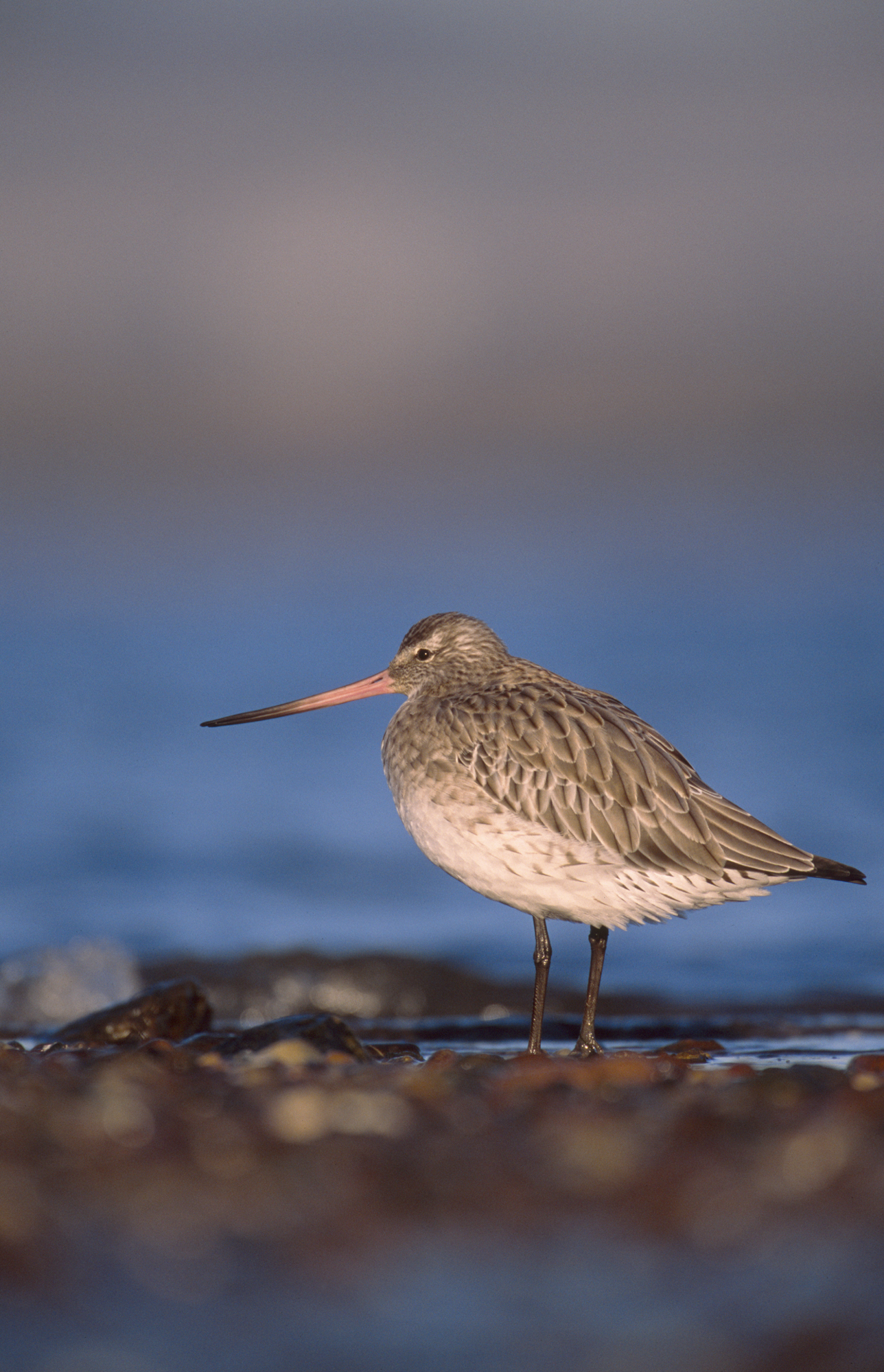
Though slightly smaller than black-tailed godwits with shorter legs and a more tapered bill, this can be difficult to see from a distance, with the difference in plumage being the most useful tool for distinguishing between the two species. Their legs are a grey/blue colour and the bill, which has a slight upward curve, is pink at the base and black at the tip. The male’s bill changes during the breeding season and becomes completely black. While there may be some rusty colour during the breeding season, the back feathers usually remain a grey colour throughout the year. In the summer, the head, chest and belly become a rusty red colour (compared to the black-tailed’s white belly), with the head and chest becoming a grey/brown colour over winter, and the belly an off-white. There is usually a paler stripe over the eye, giving the appearance of an eyebrow. Juvenile bar-tailed godwits’ plumage colour is a litter brown, similar in colour to curlew. While black-tailed godwit stand and move in an upright position, using sight as much as touch to find their prey, bar-tails have a forward leaning stance and rotate their head as they search for food.
When flying you can see the distinctive white V on the back and the bars across the end of the tail. Their shorter legs are also obvious as only the feet can be seen projecting out the back.
Whimbrel.
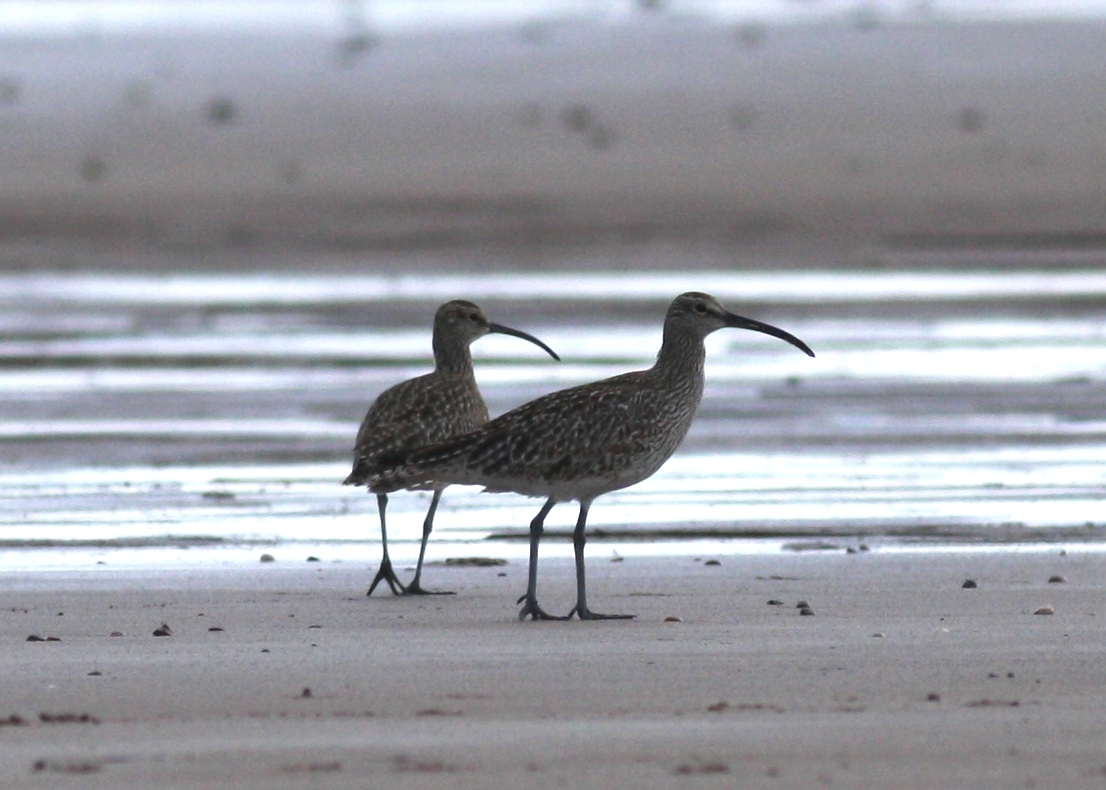
Easily mistaken for a curlew, the whimbrel is very similar in bill and body shape. While it is smaller, by about three or four inches, with a shorter bill, the easiest way to identify it is by its plumage. Whimbrel’s have a white rump, with dark grey/brown wings and tail feathers. The chest feathers are also a darker brown than the curlew. But, its most striking feature is the distinctive stripes found along the head. Juveniles vary from the adults by having a ‘neater’ appearance.
And that ends our little id series on waders found at the Basin. The best time to see them is at low tide when they move out across the mud. The Visitor Centre gives the best vantage point, but the Wigeon Hide as the tide comes in is also a good place to see them (you’ll need to bring your own binoculars though).
For those interested in the geese numbers, an up-date will be given on the blog Sunday.
Georgina Bowie (Visitor Centre Assistant)
Help protect Scotland’s wildlife
Our work to save Scotland’s wildlife is made possible thanks to the generosity of our members and supporters.
Join today from just £3 a month to help protect the species you love.
Preface
This week we’ll be looking at the last of the waders you’re most likely to see at Montrose (of course there are more, but they’re just not as common). This …
